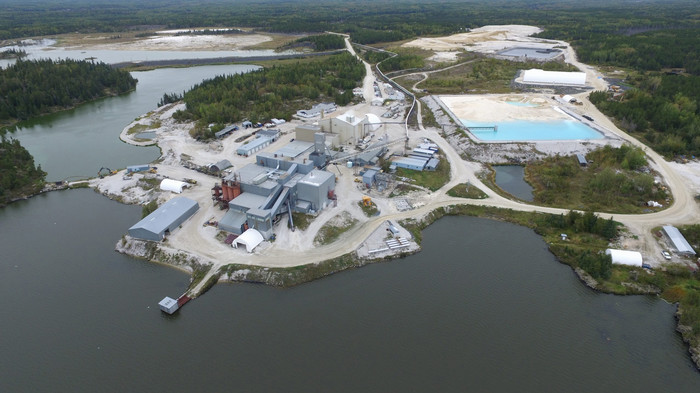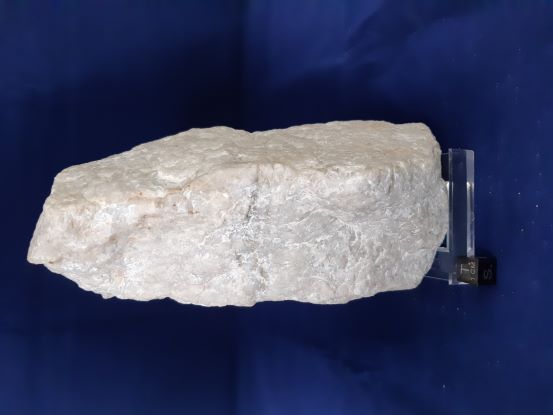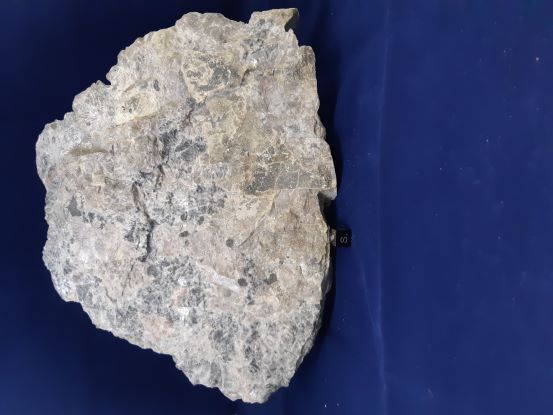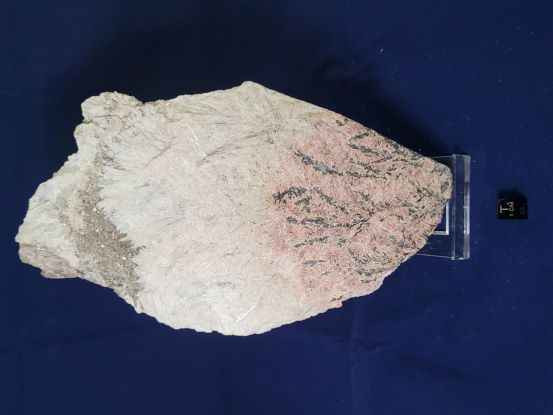Resources
We are located at:
North Campus BuildingRoom 120
Western University
1151 Richmond St. N.
London, Ontario
N6A 5B7 Canada
geocollections@uwo.ca
Critical Minerals
Canada and the Transition to Green Energy
A fully green economy greatly increases demand for minerals referred to as “critical minerals” (Fig 1). Each country has its own defined list of critical minerals. In 2022, Canada implemented the Canadian Critical Minerals Strategy (CCMS). The list of Canadian Critical Minerals is shown in Figure 2. These minerals are vital in clean technologies such as solar panels and batteries, as well as telecommunications, computing, and aerospace technologies. This rapid technological transformation in the ways that we produce and use energy creates a challenge to produce these elements sustainably and equitably.

Figure 1. 2017 production vs estimated 2050 demand for select critical minerals
From Sovacool, B.K., et al. (2020). Sustainable minerals and metals for a low-carbon future. Science, 367(6473), 30-33.

Figure 2. Canada’s currently defined 31 critical minerals and some of their uses
From https://www.canada.ca/en/campaign/critical-minerals-in-canada/canadian-critical-minerals-strategy.html
Lithium in Canada
Canada is positioned to become a major producer of critical minerals due to the country’s varied geology (Fig 3). In 2023, there are two mines producing lithium from pegmatites in Canada, the North American Lithium deposit near Val d’Or, Quebec, and the Tanco deposit, northeast of Winnipeg, Manitoba (Fig 4). In addition to lithium, Tanco also produces cesium and is a former producer of tantalum. Pegmatites form from the final residual magmas of a crystallizing magma body. They are highly enriched in critical and rare-earth elements which are not normally compatible in typical rock forming minerals. The Tanco pegmatite is particularly rich in the mineral pollucite – a cesium-sodium-aluminum silicate – and contains over 82% of known global reserves of cesium.

Figure 3. Locations of potential critical mineral development across Canada
From https://www.canada.ca/en/campaign/critical-minerals-in-canada/canadian-critical-minerals-strategy.html

Figure 4. An aerial photo of the Tanco Mine, located on Bernic Lake in Manitoba, Canada
Photo from https://tancomine.com/
Minerals From Other Localities
In addition to specimens from the Tanco Mine are examples of a selection of critical minerals both from Canada and around the world. These include columbite and pyrochlore - ore minerals of niobium; niocalite - a rare niobium silicate mineral; tantalite - the main ore mineral of tantalum; spodumene - one of the main ore minerals of lithium; eudialyte - a minor ore mineral of zirconium; and wolframite - the main ore mineral of tungsten. The niocalite and pyrochlore are from Oka, Quebec, a carbonatite complex and former producer of niobium that is also enriched in rare earth elements (REEs). The only niobium mine located outside of Brazil is Niobec in Quebec. The eudialyte is from the Kipawa alkaline complex that hosts a polymetallic rare element deposit (Zircon-REEs), where the eudialyte is one of the three main economic ore minerals.
Acknowledgements
This display poster was created by student volunteer Dana Halay, with assistance from Dr. Alysha McNeil and Ian Nicklin. Large specimen mount created by Jon Jacobs. Display set up by Olivia Benest and Dr. Alysha McNeil. Thank you to Dr. Robert Linnen for feedback on the poster text and design.
Dana Collection - Tantalite

Dana Collection Sample Number 2688 - Tantalite
Colorado, USA
Specimen donated February 1968 by Donald C. Swanson of Houston, Texas.
Pictured: Part of a dull black striated crystal of tantalite, 2" x 1 1/2"x 7/8" inches.
Chemical Formula: (Fe,Mn)Ta2O6
Tantalite is a tantalum oxide mineral containing variable amounts of manganese and iron. It is the primary ore mineral of tantalum. It is used an alloying agent in metals including surgical steel and in glasses to change the index of refraction, and is used in capacitors in electronics.
Dana Collection - Columbite

Dana Collection Sample Number 2926 – Columbite
Ingersoll mine, Keystone, South Dakota, USA
Specimen purchased September 1969 from Filer’s.
Pictured: Heavy black sub-metallic coarse platy crystals of columbite from a pegmatite with glassy gray quartz and some muscovite. Crystals are as much as 3 x 1/2" in section, and are broken along length.
Chemical Formula: (Fe,Mn)Nb2O6
Columbite is a niobium oxide mineral that is closely related with tantalite. The mineral contains variable iron and manganese. Niobium is used as an alloying agent in jet engines, rockets, and structural materials. At low temperatures (<9.3 K) it displays superconductivity and is used in particle accelerators and nuclear magnetic resonance (NMR) spectrometers.
Dana Collection - Eudialyte

Dana Collection Sample Number 2971 – Eudialyte
Sheffield Lake, Kipawa Lake Area, Quebec, Canada
Specimen donated November 1969 by Chas. Blackburn.
Pictured: Granular, pink-rose eudialyte associated with columnar aegirine-augite, magnesian arfvedsonite, milky albite, and microcline. The amorphous brown accessory is thorite.
Chemical Formula: Na4(Ca,Ce)2(Fe,Mn,Y)ZrSi8O22(OH,Cl)2
Eudialyte is a rare cyclosilicate mineral and is a minor ore of zirconium. Industrial use of this mineral is limited; however, it can contain uranium and lead make it a useful geochronometer.
Dana Collection - Niocalite

Dana Collection Sample Number 3114 – Niocalite
Oka, Quebec, Canada
Specimen donated January 1971 by Jacques Grenier.
Pictured: Several greenish yellow prismatic crystals of niocalite in calcite-rich matrix. One is 3/4" long, one of the largest ever found.
Chemical Formula: Ca14Nb2(Si2O7)4O6F2
Niocalite is a rare niobium sorosilicate mineral first described by Dr. E.H. Nickel in drill core from the Oka carbonatite in Quebec.
Dana Collection - Pyrochlore

Dana Collection Sample Number 3143 – Pyrochlore
Open Pit, St. Lawrence Columbium and Metal Corp. Oka, Quebec, Canada
Specimen donated May 6th, 1971 by Dr. G. Gordon Suffel
Pictured: Carbonatite with several crystals pyrochlore up to about 8mm including one very well-formed octahedron.
Chemical Formula: (Na,Ca)2Nb2O6(OH,F)
Pyrochlore is a complex oxide mineral containing significant amounts of niobium. It is the principal ore of niobium, with the three largest niobium mines in the world producing from pyrochlore deposits. The pyrochlore structure is currently being studied for uses in electronics and superconductors.
Dana Collection - Wolframite

Dana Collection Sample Number 6381 – Wolframite
Panasqueira Mine, Castelo Branco District, Centro Region, Portugal
Specimen donated in 2006 by Arnim Walter.
Pictured: Large black crystal of wolframite.
Chemical Formula: (Fe,Mn)WO4
Wolframite is an iron-manganese tungstate mineral and is an important ore of tungsten. Tungsten is used as filaments, in tools as tungsten carbide, and as chemical catalysts and lubricants. Tungsten is a refractory element and has the highest melting temperature of any element (3422°C). This allows for material containing tungsten to be used in high temperature applications.
Suffel Collection - Pollucite

Suffel Collection Sample Number 10583 – Pollucite
At top of raise from S. drift, 1st level, Tanco Mine, Bernic Lake, English River District, Manitoba, Canada
Specimen donated December 13th, 1968 by Dr. R.W. Hutchinson.
Pictured: Nearly pure pollucite with a milky colour.
Chemical Formula: (Cs,Na)2(Al2Si4O12) · 2H2O
Pollucite is a cesium-rich zeolite mineral that is found in association with lithium pegmatites. Cesium is used as a drilling fluid. The majority of the world’s pollucite reserves (82%) are located at the Tanco mine in Manitoba, Canada.
Suffel Collection - Lepidolite

Suffel Collection Sample Number 10605 - Lepidolite
Tanco Mine, Bernic Lake, English River District, Manitoba, Canada
Specimen donated December 1956 or January 1957 by Dr. R.W. Hutchinson.
Pictured: Nearly massive lepidolite with albite var. cleavelandite along one edge and trace quartz.
Chemical Formula: K(Li,Al)3(Al,Si,Rb)4O10(F,OH)2
Lepidolite is a phyllosilicate that is found in association with lithium-bearing pegmatites. It is a secondary ore of lithium and major source of rubidium. Lithium is known for its use in battery technologies and is an increasingly important commodity as Canada transitions to a green economy. Rubidium is used in atomic clocks for the telecommunications industry.
Suffel Collection - Spodumene

Suffel Sample Number 17163 - Spodumene
Noumas Mine, Cape Province, South Africa
Specimen donated April 4th, 1974 by Dr. R.W. Hutchinson.
Pictured: Coarse grey-green spodumene with albite var. cleavelandite and quartz.
Chemical Formula: LiAlSi2O6
Spodumene is a lithium-bearing pyroxene and the principle ore or lithium in hard rock deposits. Spodumene occurs in pegmatite deposits. Approximately half of current lithium production is from hard rock lithium deposits consisting mainly of spodumene.
Suffel Collection - Cesium-rich Beryl

Suffel Sample Number 30456 - Cesium-rich beryl
Beryl Pit, Tanco Mine, Bernic Lake, English River District, Manitoba, Canada
Specimen collected approximately 1999 and donated in 2023 by Dr. R.L. Linnen.
Pictured: Very large hexagonal white beryl. White beryl specimens from Tanco are Cesium-rich.
Chemical Formula: (Na,Cs,K,Fe,H2O)Be3Al2Si6O18
Cesium beryl is a very rare form of the cyclosilicate mineral beryl. The beryl group includes precious gems such as emerald and aquamarine.
Suffel Collection - MQM Alteration

Suffel Sample Number 30465 - Mica-Quartz after Microcline (MQM) Alteration
Tanco Mine, Bernic Lake, English River District, Manitoba, Canada
Specimen collected approximately 1999 and donated in 2023 by Dr. R.L. Linnen.
Pictured: Large MQM mineralization with columbite-tantalite.
The microcline to quartz-mica alteration style (termed MQM) is a distinct style of alteration known to host high grade tantalum mineralization at the Tanco mine in Bernic Lake, Manitoba.
Suffel Collection - Columbite-tantalite mineralization

Suffel Collection Sample Number 30470 - Columbite-tantalite mineralization
Tanco Mine, Bernic Lake, English River District, Manitoba, Canada
Specimen collected approximately 1999 and donated in 2023 by Dr. R.L. Linnen.
Pictured: Very coarse grained columbite-tantalite mineralization.
Chemical Formula: (Fe,Mn)(Ta,Nb)2O6
Col-tan mineralization includes the oxides columbite and tantalite which are rich in niobium and tantalum, respectively. No mining of col-tan currently occurs in Canada due to environmental regulations, although one mine has been proposed in British Columbia.
Suffel Collection - Dendritic columbite

Suffel Collection Sample Number 30471 – Dendritic columbite
511 Zone, Tanco Mine, Bernic Lake, English River District, Manitoba, Canada
Specimen collected approximately 1999 and donated in 2023 by Dr. R.L. Linnen.
Pictured: Dendritic columbite in hematitic alteration of feldspar (cleavelandite).
Chemical Formula: (Fe,Mn)Nb2O6
Columbite is a dark brown to black mineral oxide containing niobium. Dendritic crystal growth forms when crystallization is rapid, and are often conditions associated with disequilibrium.

